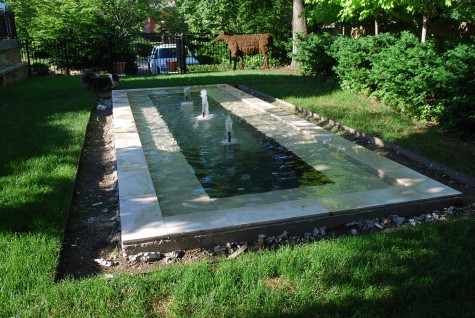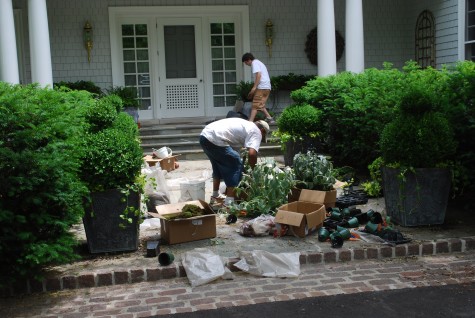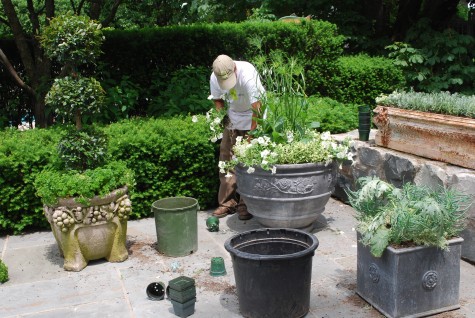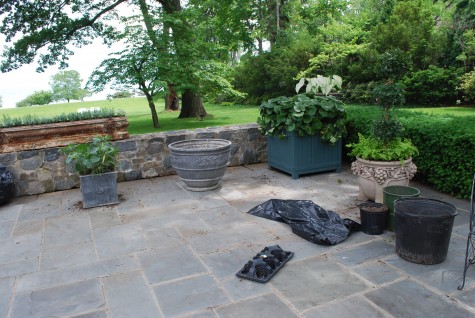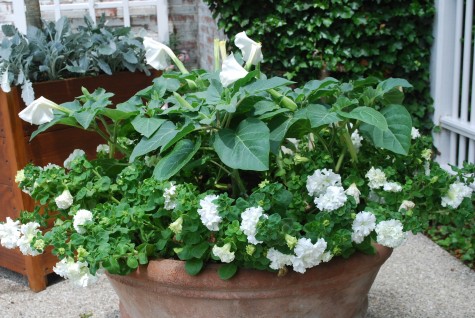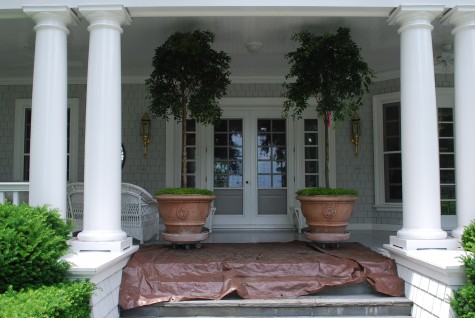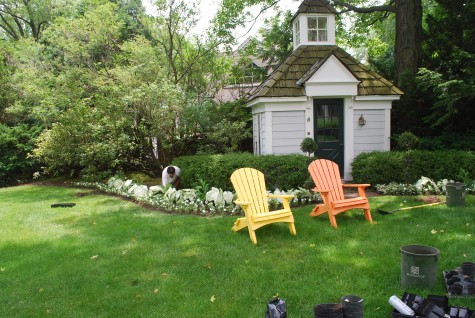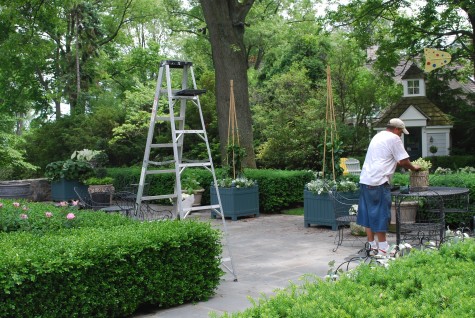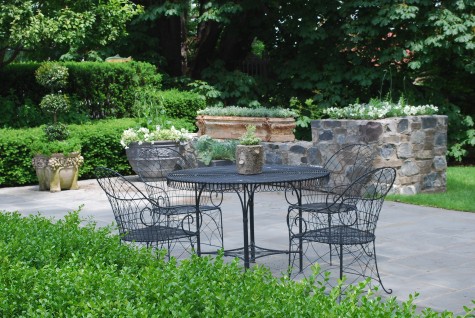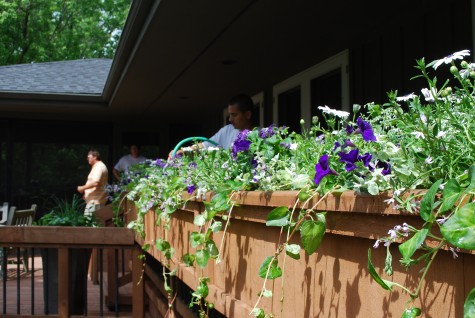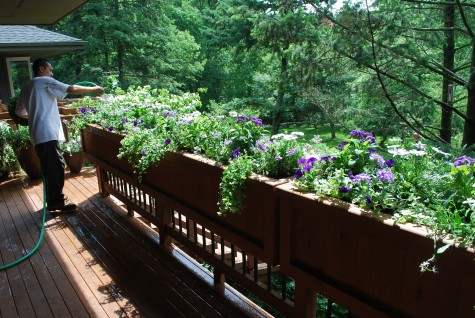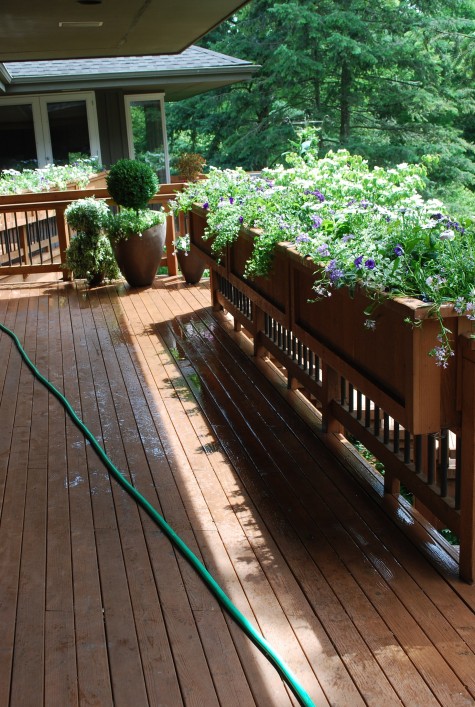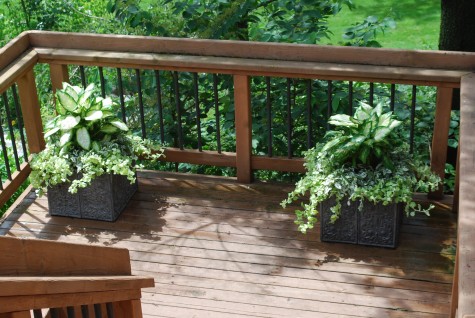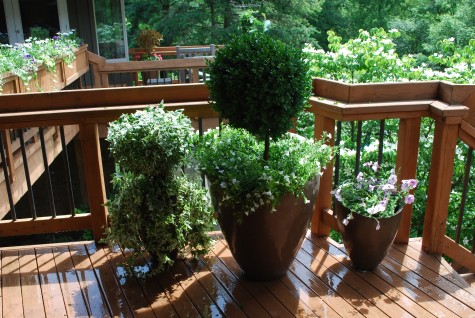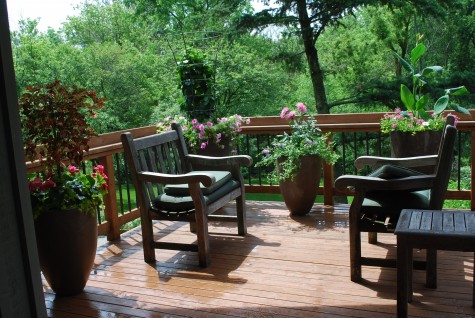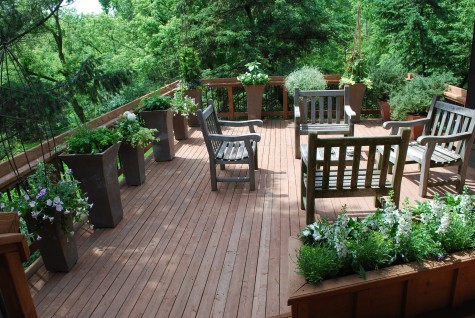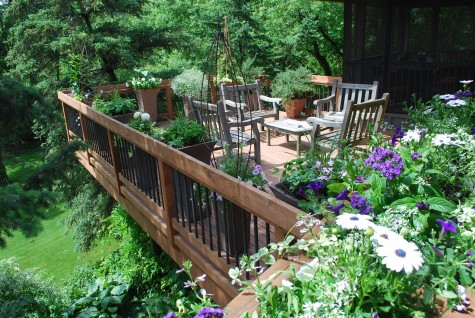 These early June days, my days are filled with projects, and those scraps and pieces more commonly known as following up. The fulfillment of all of those little ending details that transforms a job to be done into a finished and beautiful presentation. These big things and little things, at the same time, is the normal course of events. At home, a big and little thing of my own. Carter has rebuilt my leaking fountain, and Buck repainted the inside. The chlorinated rubber pool paint has to cure five days before the pool can be filled. It seems like it has been a lifetime since I have had my water.
These early June days, my days are filled with projects, and those scraps and pieces more commonly known as following up. The fulfillment of all of those little ending details that transforms a job to be done into a finished and beautiful presentation. These big things and little things, at the same time, is the normal course of events. At home, a big and little thing of my own. Carter has rebuilt my leaking fountain, and Buck repainted the inside. The chlorinated rubber pool paint has to cure five days before the pool can be filled. It seems like it has been a lifetime since I have had my water.
 Post the appropriate waiting period, Buck is filling the fountain. Gillette Pools installed new out take jets-installed properly in the wall of the basin. The original pool had these jets installed in the stone riser-not such a good look. Lest you not understand the effort expended for my fountain by Gillette Pools, they took on a massive mess, and made it right. They took on a deconstruction and reconstruction; this is tedious and uncertain work. I had to commit to the project before what they knew what it would take to fix it. Yikes! Though we cleaned the inside, the sandy grit from the concrete work is still visible on the bottom of the pool.
Post the appropriate waiting period, Buck is filling the fountain. Gillette Pools installed new out take jets-installed properly in the wall of the basin. The original pool had these jets installed in the stone riser-not such a good look. Lest you not understand the effort expended for my fountain by Gillette Pools, they took on a massive mess, and made it right. They took on a deconstruction and reconstruction; this is tedious and uncertain work. I had to commit to the project before what they knew what it would take to fix it. Yikes! Though we cleaned the inside, the sandy grit from the concrete work is still visible on the bottom of the pool.
 Howard and Milo are happy about getting their overscaled water dish back; the moment water started pouring into the fountain, they were there checking it out. Sometimes I leave the water at the level shown here-sometimes I fill it all the way to the top. Today, I am feeling like to the top is an excellent idea. If you think this was the equivalent of Christmas Day to me, you are right.
Howard and Milo are happy about getting their overscaled water dish back; the moment water started pouring into the fountain, they were there checking it out. Sometimes I leave the water at the level shown here-sometimes I fill it all the way to the top. Today, I am feeling like to the top is an excellent idea. If you think this was the equivalent of Christmas Day to me, you are right.
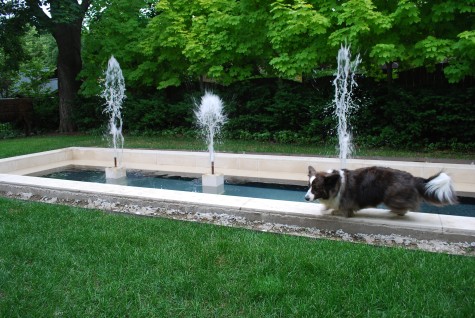 Milo is in motion running for his life the very second water starts blasting out of those jets. How did I know when the exact moment was at hand? Buck and I were on the phone with each other-as he needed to be in the basement to adjust the valves governing the height of the water. I was so worried the pumps would not work at all-having been silent almost 10 months. No science here-just a nagging worry that something else would go wrong. Buck had hauled the filters outside and cleaned them, and was very confident all would work fine.
Milo is in motion running for his life the very second water starts blasting out of those jets. How did I know when the exact moment was at hand? Buck and I were on the phone with each other-as he needed to be in the basement to adjust the valves governing the height of the water. I was so worried the pumps would not work at all-having been silent almost 10 months. No science here-just a nagging worry that something else would go wrong. Buck had hauled the filters outside and cleaned them, and was very confident all would work fine.
 The water coming out of the jets-old stinky and dirty water. It will take a few minutes for each jet to be flushed out, and spouting clean water. The corgis are no where to be seen. Then the tedious job of getting the jets adjusted so the height is just so-meaning high enough to make enough sound to blotto the sound of my neighbor’s lawn mower. The sound that a jet of water produces is the best part of having a fountain.
The water coming out of the jets-old stinky and dirty water. It will take a few minutes for each jet to be flushed out, and spouting clean water. The corgis are no where to be seen. Then the tedious job of getting the jets adjusted so the height is just so-meaning high enough to make enough sound to blotto the sound of my neighbor’s lawn mower. The sound that a jet of water produces is the best part of having a fountain.
 Each valve gets turned up or down and up again until the pressure produces spouts of equal height.
Each valve gets turned up or down and up again until the pressure produces spouts of equal height.
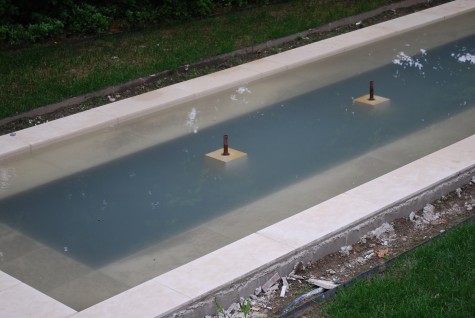 The water is murky with mortar and dirt. It will take a few days stirring up and filtering out before the water is clean. The reconstruction was such a beautiful job; the water appears to my eye to be exactly level-as if the fountain had a sheet of glass over the top.
The water is murky with mortar and dirt. It will take a few days stirring up and filtering out before the water is clean. The reconstruction was such a beautiful job; the water appears to my eye to be exactly level-as if the fountain had a sheet of glass over the top.
 In another few days, the water is clean, and the Corgis are back to drinking from it like nothing had ever happened. But I know plenty has happened-and more is yet to come. Dealing with the damage to the landscape is the next order of business. There is more work to go than what I would like. The good part-I have the luxury of rethinking certain parts of the composition. Luxury from disaster-this is what I call trying to keep a good attitude going.
In another few days, the water is clean, and the Corgis are back to drinking from it like nothing had ever happened. But I know plenty has happened-and more is yet to come. Dealing with the damage to the landscape is the next order of business. There is more work to go than what I would like. The good part-I have the luxury of rethinking certain parts of the composition. Luxury from disaster-this is what I call trying to keep a good attitude going.
